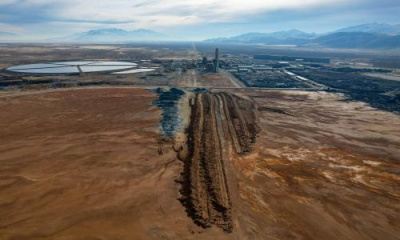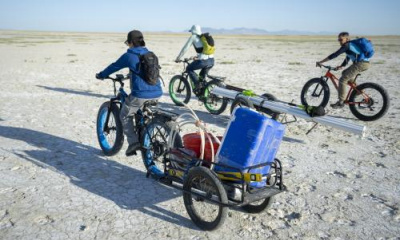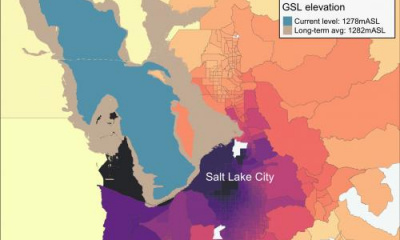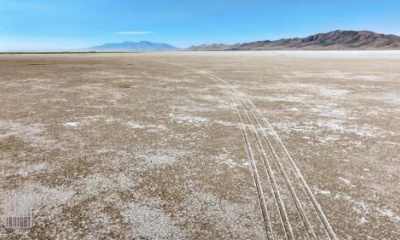Editor’s note: This story is part of Reaching for Air — a collaboration of The Salt Lake Tribune, KUER and the Brown Institute for Media Innovation, which explores air quality along the Salt Lake Valley’s west side. If you would like to share your story, please complete this survey or leave a voice message at 385-419-2470.
Bad air days in the Salt Lake Valley end with soft blood-orange skies and pillowy clouds. Those sunsets can be breathtaking, but the reality behind them is more perilous than picturesque.
Particles mirror the light of the sun setting on the horizon while homes and refineries on the west side shape the skyline. The melting pot of sunset colors comes from polluting particulates in the air — not from nature itself.
Rose Park resident Sarah Balland describes these dusky displays as “eerily beautiful.” They’re not like the “real” sunsets in her hometown of Cheyenne, Wyo., but still, spectacular.
While most emissions that pollute the valley’s air come from cars, Balland finds that being surrounded by refineries, watching gases plume and smells intensify, “does something” to her mind. The thick air not only makes it harder for her to breathe but also disgusts and angers her.
Though Balland has experience as a community organizer and participates in the discussions that happen in her neighborhood, speaking with elected officials about this pollution is at times disappointing. She fears her messages and comments are frequently ignored and that her efforts go unseen.
“I just wonder,” she said, “if they are fighting for us.”
What gets in the way of speaking?
The Salt Lake Tribune and KUER spoke with dozens of west-siders about what kept them from engaging with officeholders. In predominantly blue-collar neighborhoods, their busy schedules and lack of expectation that any structural changes would occur prevailed.
Like Balland, many west-siders don’t reap the benefit of engaging or contacting their representatives. Some don’t know how to reach out to them, and many have a hard time in their stacked schedules to attend public meetings.
“It's hard to know who to talk to,” Rose Park resident Sam Langi said. “There's a lot of people from different cultural backgrounds so there could be language barriers, and it’s really hard to work full time and come home and then, you have to cook dinner and have a life.”
Glendale resident Matthew Morriss does engage with his city and state elected leaders. He lets them know about his concerns on dust and inversions and his wish to push for more electrification. But he wonders if those he approaches can really get things done.
“There's only so much that certain politicians can do being in the political minority as we are,” he said. “I would say that the folks that I'm talking to at least are in the political minority.”
What elected leaders have to say
For West Valley City Council member Jake Fitisemanu, the lack of public engagement in environmental issues like air quality does not reflect his constituents’ interest in the problem.
“Folks can be working multiple jobs and be serving in their communities and also be concerned about the environment,” he said. “But a lot of them don't know how to get involved or don't know what kinds of changes they can make in their own lives.”
Like many west-siders who watch their kids’ asthma exacerbate on bad air days, he wishes it could be treated as a “human issue” and that officials would allocate more resources for those disproportionately impacted. And he would like to see more data to inform decisions.
“We can do a better job of identifying the information that's relevant,” he said, “and being able to disseminate that in usable, digestible ways so that people can actually understand what these impacts are locally.”
‘You better show up’
Salt Lake City Council member Victoria Petro, who represents the west side’s District 1, understands this pattern. Historically, the voices of residents west of Interstate 15 haven’t been heard, she said, which makes many of her constituents question if speaking up is worth it.
To tackle issues like air quality with public participation, she said, governments need to address other priorities.
“If you want long-term engagement and responsiveness, because things like air quality are going to require that, you better show up,” she said. “You better see them as humans, and you better show up repeatedly and then you can ask them to respond to you.”
The problem, Petro said, shouldn’t be seen through a partisan lens. “We live in a time where you have to choose if you're going to fight a culture war or you're going to manage growth and protect Utahns.”
Though the city administration has been “visionary” on what it can do to address air quality, Petro added, its efforts may seem small when compared to the scope of the pollution.
“It's heartbreaking that people on the west side have to wonder if someone is fighting for them,” she said. “And it does feel sometimes like a drop in a bucket of what we can do.”
‘We are fighting for them’
As a state lawmaker and longtime west-sider, House Minority Leader Rep. Angela Romero, D-Salt Lake City, knows “the air we breathe is not equal, and it never has been.”
At Utah’s Capitol, she pushes for legislators “to look at the history of the west side of Salt Lake City and how, in the past, many people on the west side feel like they've been neglected, and they still at times feel like their issues aren't being addressed.”
After hearing the opinions of some constituents from the montage KUER and The Tribune curated, Romero believes the government should be more diligent about reaching out to west-siders.
“It's really, really sad to hear their voices, to think that there aren't people out here fighting for them because there are,” she said. “I just want my constituents to know that I'm there, and I'm fighting for them, and I'm doing the best I can — and to continue to reach out to me.”
As a Democrat up against a Republican supermajority, Romero understands the power she yields is limited, but she isn’t powerless.
While she realized that Democrats weren’t going to prevail against the Utah Inland Port, slated to call the west side home, Romero said she and her party colleagues were able to negotiate an environmental assessment on the massive project.
“I may not always get my way, but I want them to know that they have someone at the table that's willing to fight for them and that is fighting for them all the time,” Romero said. “I'll continue to be that voice. I'll continue to be that pain in the a--. That's what I was elected to do.”
‘Contact other representatives’
When Salt Lake City Council member Alejandro Puy ran for his District 2 seat, he wanted to bridge the hopelessness that can prevent west-siders from getting involved. The discouragement is sometimes contagious, even for him, even though he holds an influential post to advocate for these neighborhoods.
“It feels like there is not enough work in the world that I could do sometimes to make sure that everybody in my district knows that I'm working as much as I can,” he said, “for the [part-time council] job that is not paying most of my bills.”
Though he encourages his constituents to hold him accountable and contact him with their concerns, he believes it’s a mistake to not include representatives from other areas in the valley like, say, Sandy, Riverton or Herriman.
“Sometimes the issues that we see in Salt Lake or in more urbanized areas, they don't see them in those areas,” he said. “So they need to have our pressure, too.”
Though he believes he could still do better, Puy added that a more empathetic Legislature could help make changes for the west side to thrive.
The west side’s real power, though, rests at the ballot box, he said. “Until the west-side voters actually register and vote in all of our elections, the power is going to be minimal.”
‘We're the boogeyman’
Republican state Sen. Todd Weiler lives on the west side of Woods Cross in Davis County and represents Senate District 8, which stretches into the Rose Park neighborhood. Utah’s five oil refineries are in his district, too.
When he ran for the Woods Cross City Council in 1999, Weiler described living in “the armpit of the refineries.”
“I live about two football fields away from one of the refineries,” he said. “It's the one that's blown up a couple of times. So, you know, my family's been evacuated.”
Air quality has been a top concern for Weiler ever since he entered politics. He established an air quality committee in Woods Cross back in the day and has been the co-chair of the Utah Legislature’s bipartisan Clean Air Caucus for nearly a decade.
He’s also seen the mindset of his GOP colleagues shift around the issue. Weiler recalls fellow Republican lawmakers “rolling their eyes” when he brought up air quality concerns during his early years in the Legislature.
“Now they don’t,” he said.
Tackling pollution has been a top priority for Utahns in recent years. A 2016 study from the Utah Foundation ranked air quality as the number two issue for residents. And the air across the Salt Lake Valley has continued to improve. While “it’s painful” as a Republican for Weiler to acknowledge, he can’t attribute those advancements to local and state action.
“Almost all of that improvement has been because of the federal government,” he said, pointing to the Clean Air Act. “It's all been federal government standards for what refineries have to do or what they can and can't do, and also for what car manufacturers have to do. That's been a game changer for air quality.”
On the state level, Weiler said the Clean Air Caucus has taken on “all of the low-hanging fruit” on air quality policy. What remains are “big budget items,” like funding free public transit, that are more difficult for legislators to hop on board with.
He also stated that lawmakers can’t “legislate away” all air pollution even if he’d like to do so. A big factor to the valley’s icky air is the reliance on vehicles to get around, he said, along with the energy it takes to heat homes and run a lawn mower.
“Everyone wants an air quality boogeyman when it's us Utahns living our lives, driving to work, driving home, heating our homes, heating our offices,” Weiler said. “We're the boogeyman. We are collectively the boogeyman. But none of us seems to want to own that responsibility.”
‘Nothing is free’
Rep. Judy Weeks Rohner represents West Valley City in House District 30 as a Republican and is relatively new to the Legislature. She prides herself on getting back to constituents and considers her phone to be another appendage because of how frequently she communicates with residents.
She said air quality is not a concern constituents approach her about but wants people to know that “nothing is free,” so even if public transportation doesn’t cost the rider something upfront, “somebody’s got to pay for it.”
Although Weeks Rohner hasn’t been “a real proponent of some of the things happening on the west side,” pointing to the Utah Inland Port as an example, she worries about the port’s health impacts and regulatory standards.
“We need to make sure that the health issues are taken care of,” Weeks Rohner said, “that if we do whatever we're going to do out there, that it benefits all the people.”
For Republican Sen. Wayne Harper, whose Senate District 16 includes most of Taylorsville and West Jordan, air quality “has always been a concern.”
He sees cleaning up the air as an opportunity everyone can participate in – even businesses.
“I drive a hybrid vehicle, and I have rooftop solar,” Harper said. “Those are individual choices that we can make and say, ‘Yeah, this is what I want to do to help.’ It'll be more efficient and also help with the air quality.”
What elected officials are doing about the air
- Petro Salt Lake City is an important player in the Community Renewable Energy Act, in which two dozen Utah cities and counties committed to a 100% clean energy goal by 2030. The city also houses a sustainability department.
- A challenge, Petro said, is when the city doesn’t incorporate environmental justiceapproaches and an understanding of structural deficiency so programs like electric bike rebates can thrive.
- Puy Though Salt Lake City is able to participate in clean energy consortiums and orders the electrification of some new buildings, there are big polluters he wishes he could regulate — including freight trains, which sometimes idle their engines for hours to keep them warm in the wintertime.
- The city also switched its fireworks spending for a laser show for this Independence Day, he said, but can’t regulate their sale.
- Fitisemanu West Valley City also hired a full-time sustainability officer. In addition, the city helps facilitate meetings for Healthy West Valley, a community-based group that explores social determinants of health, including the effects of air pollution.Though Utah’s second-largest city opted out of participating in the Community Renewable Energy Act, it set the same goal to achieve net zero emissions by 2030 on its own means, such as adding more electric vehicle charging stations and incorporating more solar alternatives.
- The municipality also adopted a “health in all policies” ordinance, which encourages that health impacts be considered in every action.
- Romero She and Senate Minority Leader Luz Escamilla, D-Salt Lake City, started the Breathe Clean Festival to educate community members, particularly on the west side about air quality. She also helped secure state funding to place air monitors on public transportation vehicles.
- Weiler The Republican senator advocated for the Legislature to fund a year of free public transit during the 2023 legislative session. His appropriations request for the pilot program failed, but he said he’ll “probably try again next year.”
- Weeks Rohner While she doesn’t have a specific bill in the works, she would like to see more west-side bus routes and an east-west TRAX expansion all the way to Magna and even Tooele. She believes the population growth and the need are there.
- “Remember, it's going to cost some dollars and somebody has to fork over that money,” she said. “But I will support whatever the community wants.”
- Harper He is working on a bill for the next legislative session that deals with net metering and rooftop solar so “people have more choices.” He also wants a “broader spectrum of involvement and equity for all the stakeholders.”








